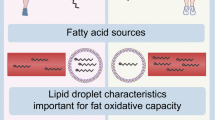Summary
In the anterior tibial muscle of rats triglyceride droplets predominantly appear within fibres rich in mitochondria (type C). In electron micrographs 3–4 of such droplets are present per 100 μm2 sectional area of C-fibres. The mean diameter of sections through fat droplets (d) is 0.69 μm, the mean diameter of the droplets (d′) as determined by Hennig's graphical method is 0.80 μm. Anaesthesia with pentobarbital (2 h) does affect neither number nor size of the particles. 2 h after application of corn oil into the stomach the number of fat droplets is unaltered, but the mean diameter has increased by 20 % (d=0.83 μm; d′=0.95 μm), corresponding to an increase of the volume of about 70 %. Pinocytosis of chylomicrones by muscle fibres has never been observed. Therefore it is supposed, that free fatty acids have passed the plasmalemma by diffusion and are incorporated into triglycerides and stored within pre-existing fat droplets.
Zusammenfassung
Elektronenmikroskopisch nachweisbare Neutralfettpartikel kommen im M. tibialis anterior der Ratte vorwiegend in den mitochondrienreichen Fasern vom Typ C in der Nachbarschaft von Mitochondrien vor. Nach Glutaraldehyd-Osmium-Fixierung und Epon-Einbettung sind diese Partikel meist dielektronisch, seltener teilweise oder ganz adielektronisch. Auf 100 μm2 Schnittfläche durch C-Fasern findet man 3–4 Anschnitte von Fettpartikeln. Der mittlere Durchmesser der Anschnitte (d) ist 0,69 μm, der mit der graphischen Methode von Hennig bestimmte mittlere Durchmesser der Fettpartikel (d′) 0,80 μm. 2 h Narkose mit Pentobarbital beeinflussen weder Anzahl noch Durchmesser der Anschnitte. Nach 2 h Resorption von Maiskeimöl ist die Zahl der Anschnitte unverändert, der mittlere Durchmesser der Anschnitte bzw. der Partikel hat um etwa 20 % zugenommen (d=0,83 μm; d′=0,95 μm). Das entspricht einer Zunahme des morphologisch nachweisbaren Neutralfettes um 70 %. Da keine Pinocytose von Chylomikronen zu beobachten ist, wird angenommen, daß freie Fettsäuren durch das Plasmalemm in die Muskelfaser eindiffundieren und im Bereich vorhandener Fettpartikel als Triglyceride gespeichert werden.
Similar content being viewed by others
Literatur
Bell, E. T. T.: The interstitial granules (liposomes) in fatty metamorphosis of striated muscle. J. Path. Bact. 17, 147–159 (1912).
Bullard, H. H.: Histological as related to physiological and chemical differences in certain muscles of the cat. Johns Hopk. Hosp. Rep. 18, 323–328 (1919).
Carlson, L. A., Liljedahl, S.-O.: Lipid metabolism and trauma. I. Plasma and liver lipids during 24 hours after trauma with special reference to the effects of guanethidine. Acta med. scand. 173, 25–34 (1963).
Elias, H., Hennig, A.: Stereology of the human renal glomerulus. In: Weibel, E. R., Elias, H. (Hrsg.), Quantitative Methoden in der Morphologie, S. 130–166. Berlin-Heidelberg-New York: Springer 1967.
Fawcett, D. W.: The cell. Philadelphia and London: W. B. Saunders Comp. 1966.
Gauthier, G. F.: On the relationship of ultrastructural and cytochemical features to color in mammalian skeletal muscle. Z. Zellforsch. 95, 462–482 (1969).
Gauthier, G. F., Padykula, H. A.: Cytological studies of fiber types in skeletal muscle. A comparative study of the mammalian diaphragma. J. Cell. Biol. 28, 333–354 (1966).
Geigy, J. R., Geigy A. G. (Hrsg.): Documenta Geigy, Wissenschaftliche Tabellen, 7. Aufl. Basel: J. R. Geigy 1968.
Göransson, G., Olivecrona, T.: The metabolism of fatty acids in the rat. I. Palmitic acid. Acta physiol. scand. 62, 224–239 (1964).
Gousios, A., Felts, J. M., Havel, R. J.: The metabolism of serum triglycerides and free fatty acids by the myocardium. Metabolism 12, 75–80 (1963).
Greene, C. W.: The storage of fat in the muscular tissue of the king salmon and its resorption during the fast of the spawning migration. Bull. U. S. Dept. Fisheries 33, 73–138 (1918).
Haug, H.: Probleme und Methoden der Strukturzählung im Schnittpräparat. In: Weibel, E. R., Elias, H. (Hrsg.), Quantitative Methoden in der Morphologie, S. 58–78. Berlin-Heidelberg-New York: Springer 1967.
Havel, R. J., Carlson, L. A., Ekelund, L.-G., Holmgren, A.: Studies on relation between mobilization of free fatty acids and energy metabolism in man: effects of norepinephrine and nicotinic acid. Metabolism 13, 1402–1412 (1964).
Havel, R. J., Felts, J. M., Duyne, C. M. van: Formation and fate of endogenous triglycerides in blood plasma of rabbits. J. Lipid Res. 3, 297–308 (1962).
Issekutz, B. J., Miller, H. I., Paul, P., Rodahl, K.: Source of fat oxidation in exercising dogs. Amer. J. Physiol. 207, 583–589 (1964).
Kölliker, A.: Mikroskopische Anatomie oder Gewebelehre des Menschen, Bd. II/1. Leipzig: Engelmann 1850.
Masoro, E. J., Rowell, L. B., McDonald, R. M., Steiert, B.: Skeletal muscle lipids. II. Nonutilization of intracellular lipid esters as an energy source for contractile activity. J. biol. Chem. 241, 2626–2634 (1966).
Maunsbach, A. B., Wirsén, C.: Ultrastructural changes in kidney, myocardium and skeletal muscle of the dog during excessive mobilization of free fatty acids. J. Ultrastruct. Res. 16, 35–54 (1966).
Neptune, E. M., Sudduth, H. C., Foreman, D. R., Fash, F. J.: Phospholipid and triglyceride metabolism of excised rat diaphragm and the role of these lipids in fatty acid uptake and oxidation. J. Lipid. Res. 1, 229–235 (1960).
Schmalbruch, H.: „Rote“ Muskelfasern. Z. Zellforsch. 119, 120–145 (1971).
Spitzer, J. J.: Metabolism of free fatty acids in skeletal muscle and myocardium. In: Rodahl, K. (ed.), Fat as a tissue, p. 215–227. New York-Toronto-London: McGraw-Hill Book Company 1964.
Stein, J. M., Padykula, H. A.: Histochemical classification of individual skeletal muscle fibres of the rat. Amer. J. Anat. 110, 103–123 (1962).
Wachstein, M., Meisel, E.: The distribution of histochemically demonstrable succinic dehydrogenase and of mitochondria in tongue and skeletal muscle. J. biophys. biochem. Cytol. 1, 483–488 (1955).
Wirsén, C.: Autoradiography of injected albumin-bound 1-C14-palmitate in pígeon pectoralis. muscle. Acta physiol. scand. 65, 120–125 (1965).
Author information
Authors and Affiliations
Additional information
Für die Hilfe bei der Planung und den statistischen Berechnungen danken wir Herrn Prof. Dr. H. Klinger, Institut für Statistik und Dokumentation der Universität Düsseldorf.
Rights and permissions
About this article
Cite this article
Hayashida, Y., Schmalbruch, H. Zur Größe der Fettpartikel in mitochondrienreichen Skelettmuskelfasern der Ratte in Abhängigkeit von der Nahrungsaufnahme. Z.Zellforsch 127, 374–381 (1972). https://doi.org/10.1007/BF00306880
Received:
Issue Date:
DOI: https://doi.org/10.1007/BF00306880




